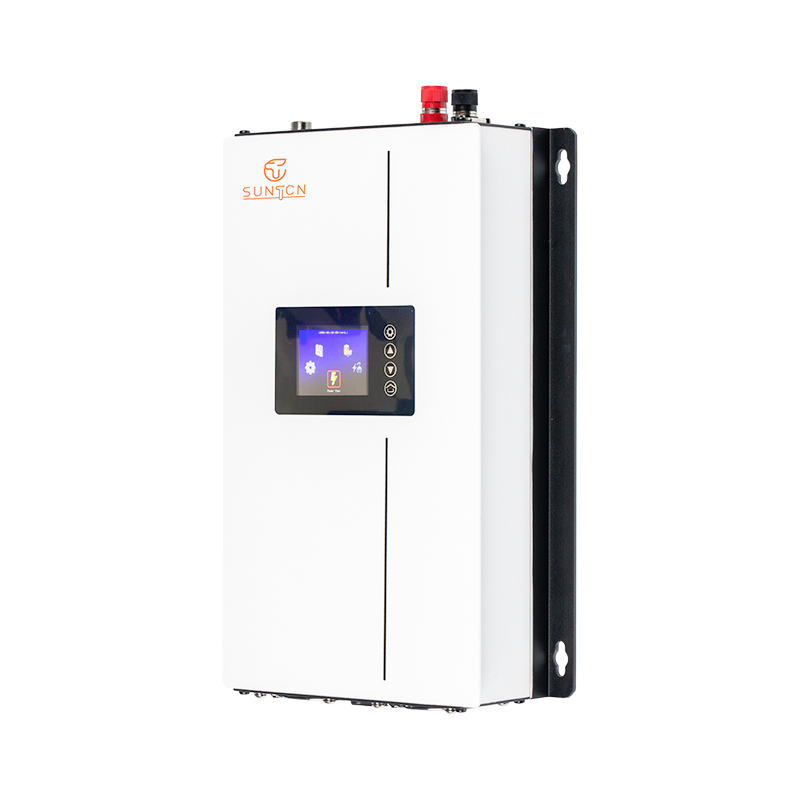With the growth of global energy demand and the popularity of renewable energy, green energy systems such as photovoltaic (PV) and wind power generation are gaining increasing attention. However, these distributed energy systems usually need to convert direct current (DC) into alternating current (AC) and transmit it to the grid safely and efficiently to achieve energy sharing and optimized utilization. The key equipment in this process is the grid tie inverter (GTI).
Grid tie inverters can convert the direct current generated by solar panels or wind turbines into alternating current that meets grid standards, and work synchronously with the grid to ensure efficient transmission of energy. This article will introduce the working principle, advantages, application scenarios and future development trends of grid tie inverters in detail.
The main function of the grid tie inverter is to convert direct current into alternating current that matches the grid frequency and feed it into the public grid. Its basic working process is as follows:

DC-AC conversion
The direct current generated by solar panels or wind turbines is input into the grid tie inverter.
The inverter is controlled by electronic switches (such as IGBT or MOSFET) to convert direct current into alternating current.
MPPT (Maximum Power Point Tracking)
The inverter detects the power point of the photovoltaic array in real time through the MPPT algorithm to ensure energy conversion efficiency.
Synchronous grid connection
The inverter detects the voltage and frequency of the public power grid and synchronizes its own AC output with the grid to ensure safe and stable integration into the grid.
Reverse current protection and safety control
The inverter contains anti-islanding protection to ensure that when the grid is powered off, the inverter will not continue to supply power to the grid to prevent endangering the safety of grid maintenance personnel.
Improve energy utilization
Optimizing energy output through MPPT technology enables photovoltaic systems or wind power generation systems to make full use of renewable energy and improve overall power generation efficiency.
Reduce energy waste
The grid-connected system can transmit excess electricity to the grid instead of storing it in the battery, reducing energy storage loss and improving energy utilization.
Reduce system costs
The grid-connected system does not need to be equipped with expensive battery energy storage equipment, reducing maintenance costs and investment costs, making photovoltaic or wind power generation systems more economical.
Promoting the development of green energy
Through the grid-connected inverter, users can transmit self-generated and self-used clean electricity to the grid, realize "green access to the grid", and promote the development of clean energy.
Intelligent control and remote monitoring
Modern grid-connected inverters usually have intelligent monitoring and remote management functions, which can be monitored in real time through Wi-Fi, Bluetooth or cloud platforms to improve the convenience of system management.
1. Home photovoltaic power generation system
The direct current generated by solar photovoltaic panels is converted into alternating current through grid-connected inverters for home use, and the remaining power can be fed back to the grid.
Applicable to application scenarios such as rooftop photovoltaic systems, self-generation and self-use, and surplus power access to the grid.
2. Commercial and industrial photovoltaic power stations
Applicable to large buildings, factories, shopping malls and other places, using roofs, parking lots and other idle areas to install photovoltaic systems, and integrate electricity into the public grid to reduce corporate electricity costs.
3. Microgrid and smart grid
In distributed energy systems, grid-connected inverters can be combined with energy storage devices to achieve intelligent management of microgrids and improve the stability and security of power supply.
4. Wind power grid-connected system
The wind power generation system is connected to the grid through a grid-connected inverter to ensure the stable output of wind energy and improve the utilization rate of wind energy.
Higher efficiency and more intelligence
In the future, grid-connected inverters will adopt more advanced power conversion technology to improve conversion efficiency and reduce energy loss.
Combined with artificial intelligence (AI) and big data analysis, automatic optimization of power output and intelligent management of the grid-connected process can be achieved.
Higher reliability and safety
Use higher quality electronic components to improve the service life and weather resistance of the inverter and adapt to more stringent outdoor environments.
Enhance anti-islanding protection and grid adaptability to improve grid security and stability.
Combined with energy storage system
In the future, grid-connected inverters will be more widely combined with energy storage systems to achieve the integration of "photovoltaic + energy storage + grid connection" and optimize power management.
Integration of distributed energy and smart grid
The development of smart grids in the future will further promote the application of grid-connected inverters and achieve seamless connection with distributed energy, smart homes, VPP (virtual power plants) and other systems.
Grid-tie inverters are core equipment for integrating renewable energy systems such as photovoltaics and wind power into the power grid. Their high efficiency, low cost and environmental protection advantages have made them widely used in many fields such as homes, businesses, industries and smart grids.
With the continuous advancement of technology, grid-tie inverters will usher in new developments in intelligence, efficiency and energy storage integration, providing strong support for the further advancement of the global clean energy industry. In the future, with the popularization of distributed energy and the development of smart grids, grid-tie inverters will play a more important role in the transformation of the global energy structure and help achieve a green and sustainable future.

 English
English Español
Español Deutsch
Deutsch










